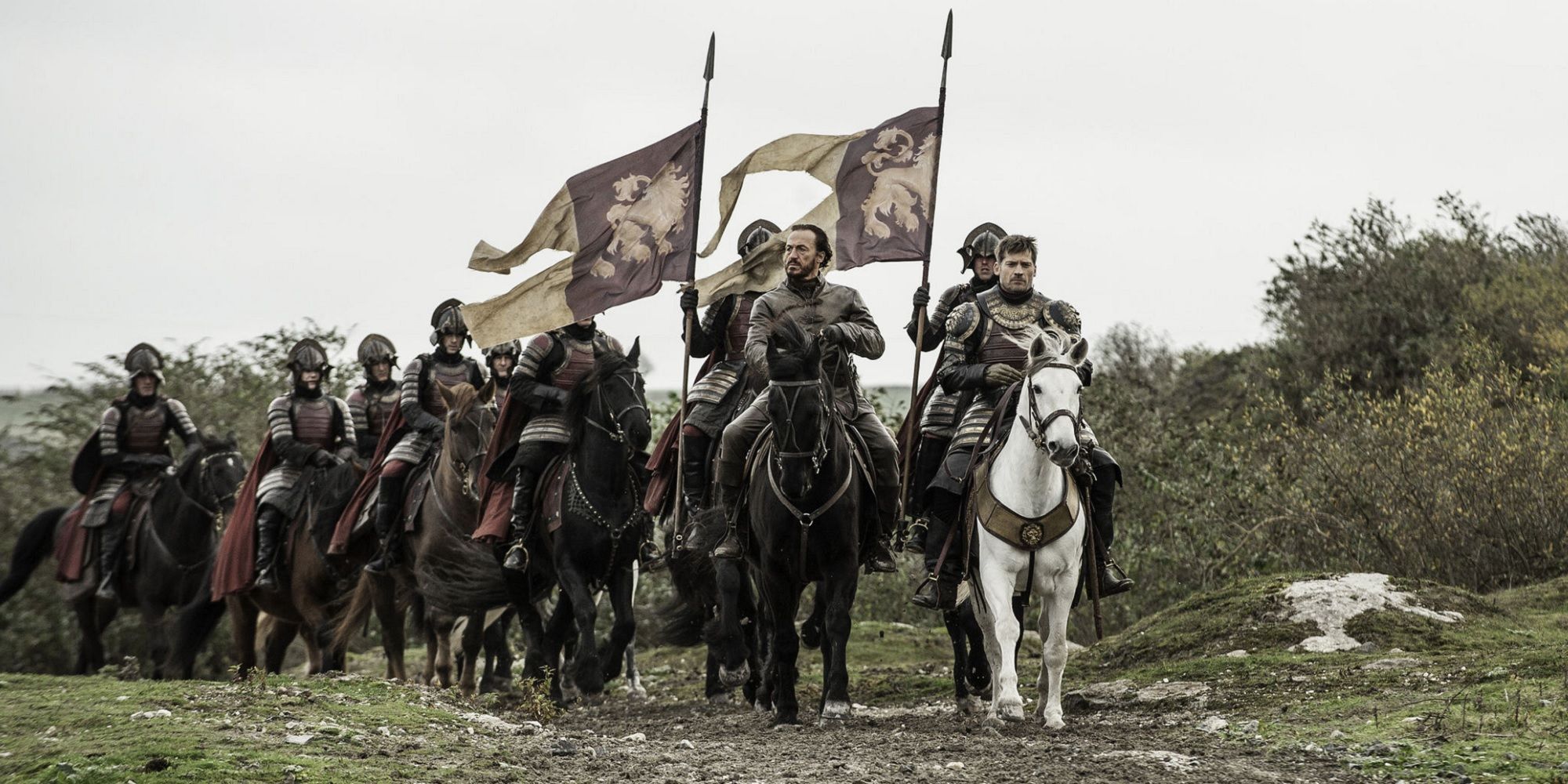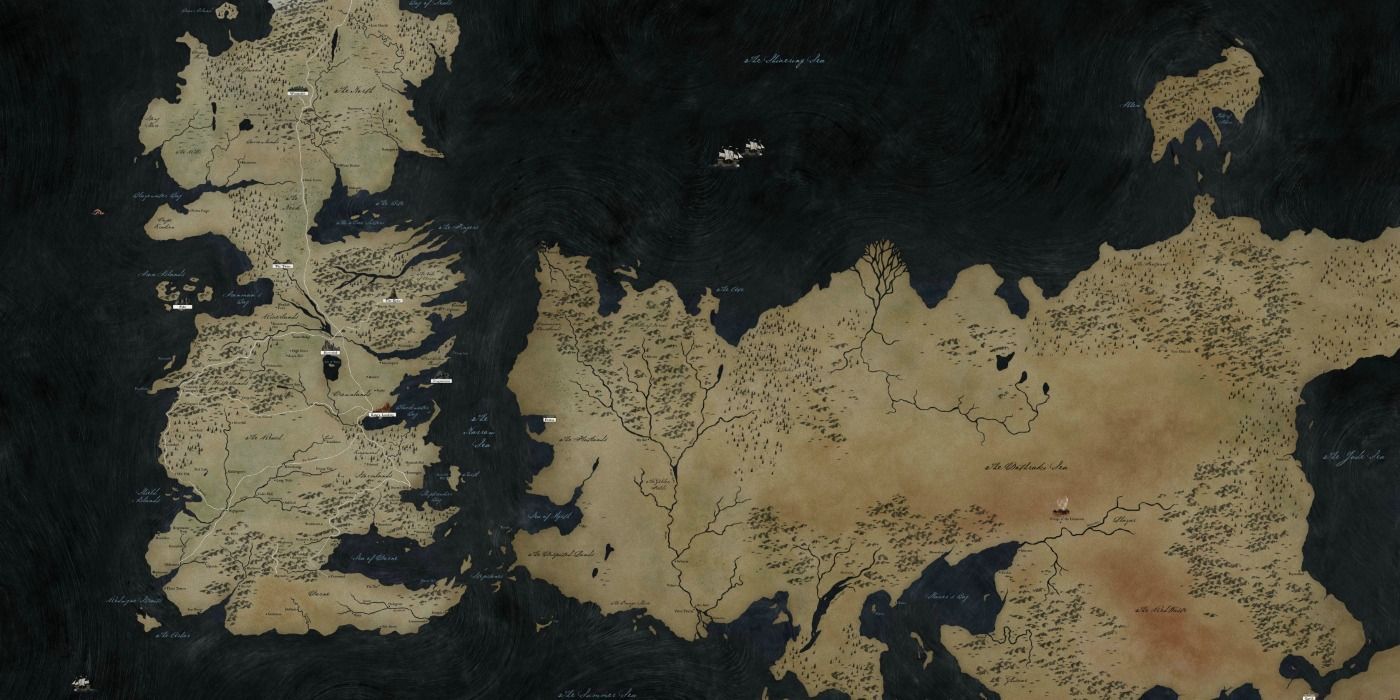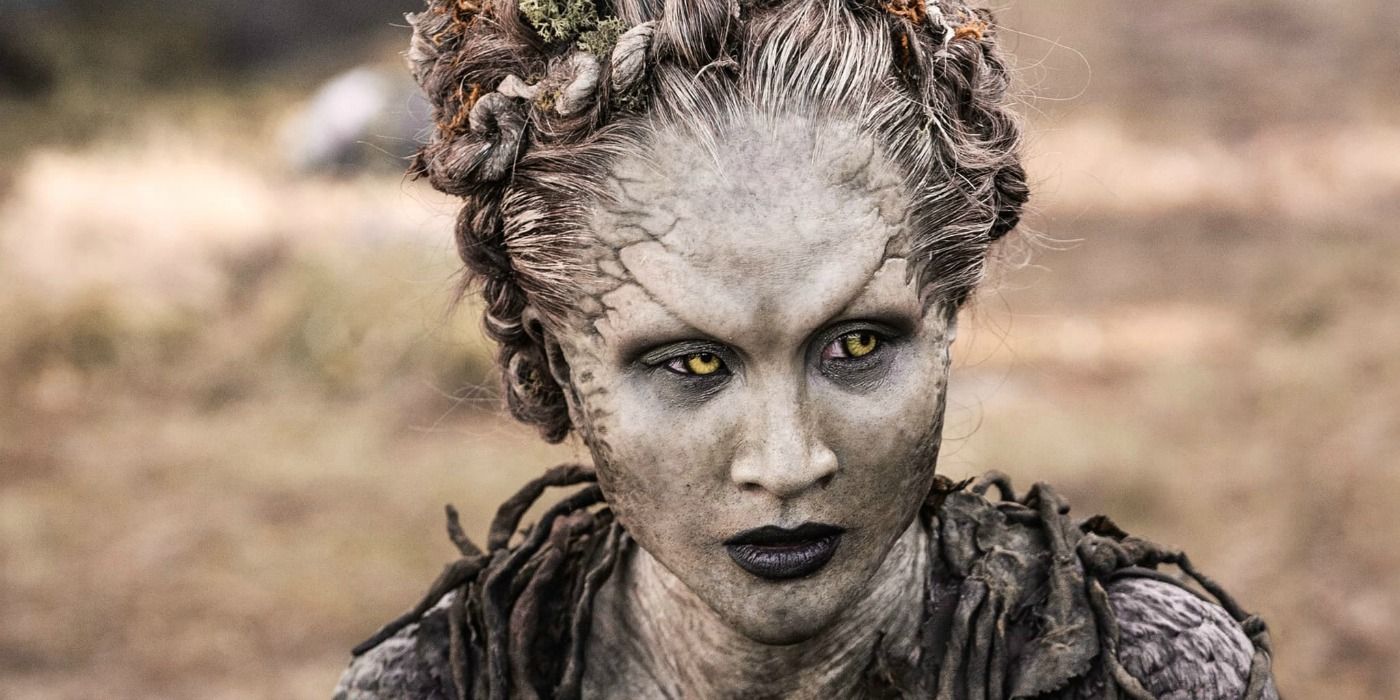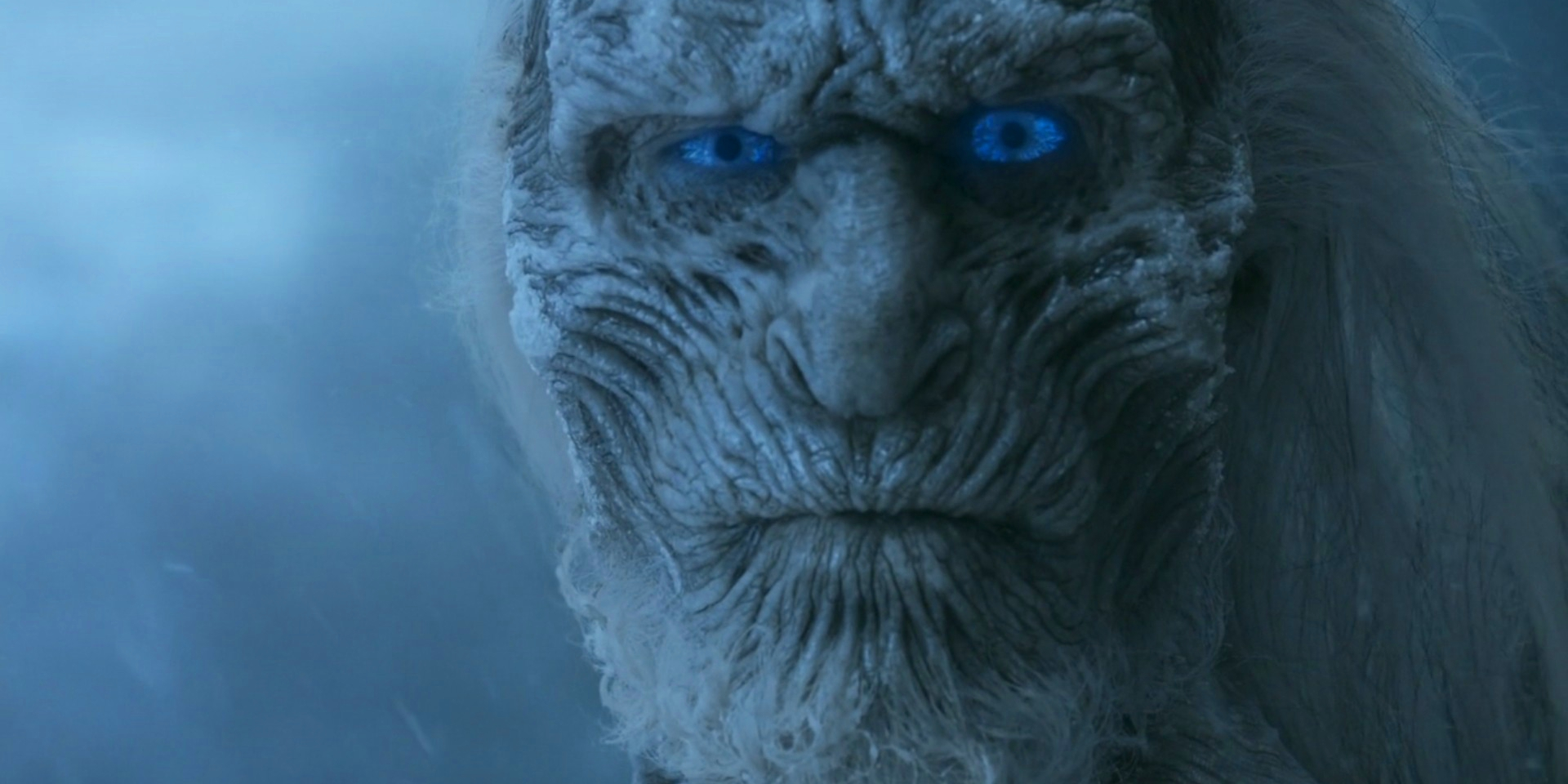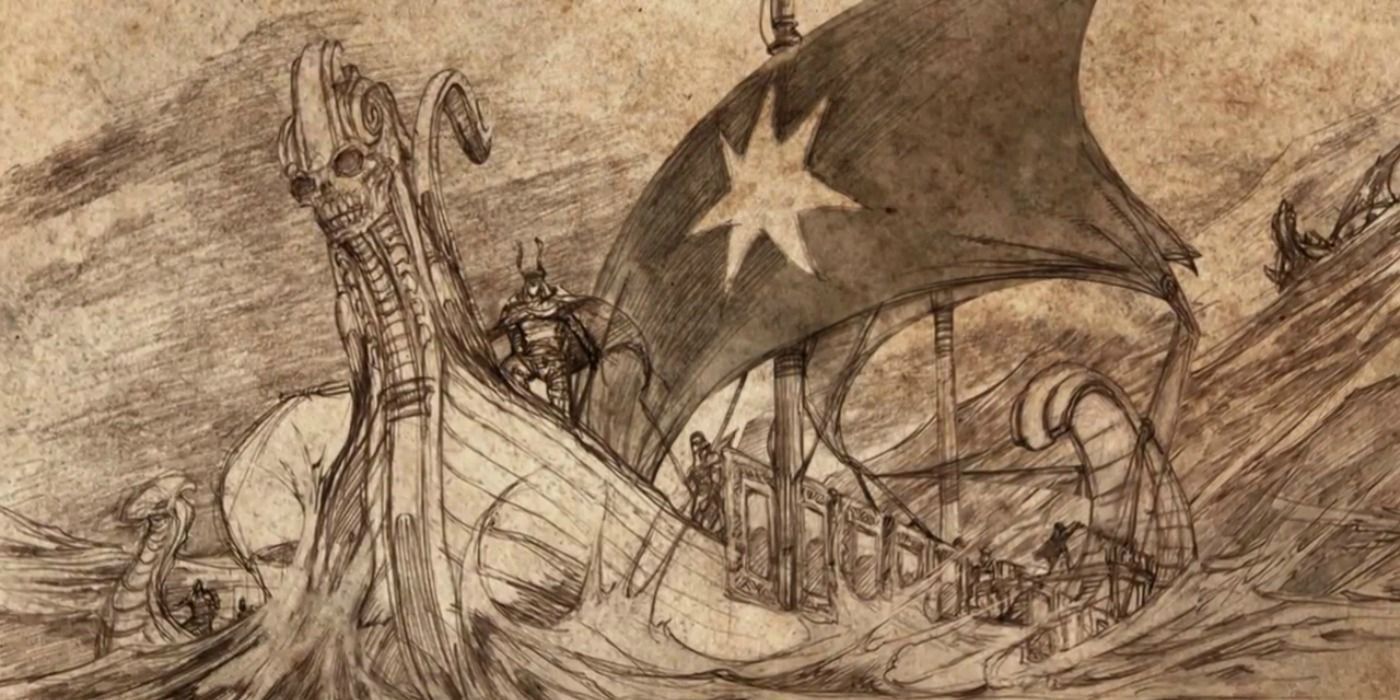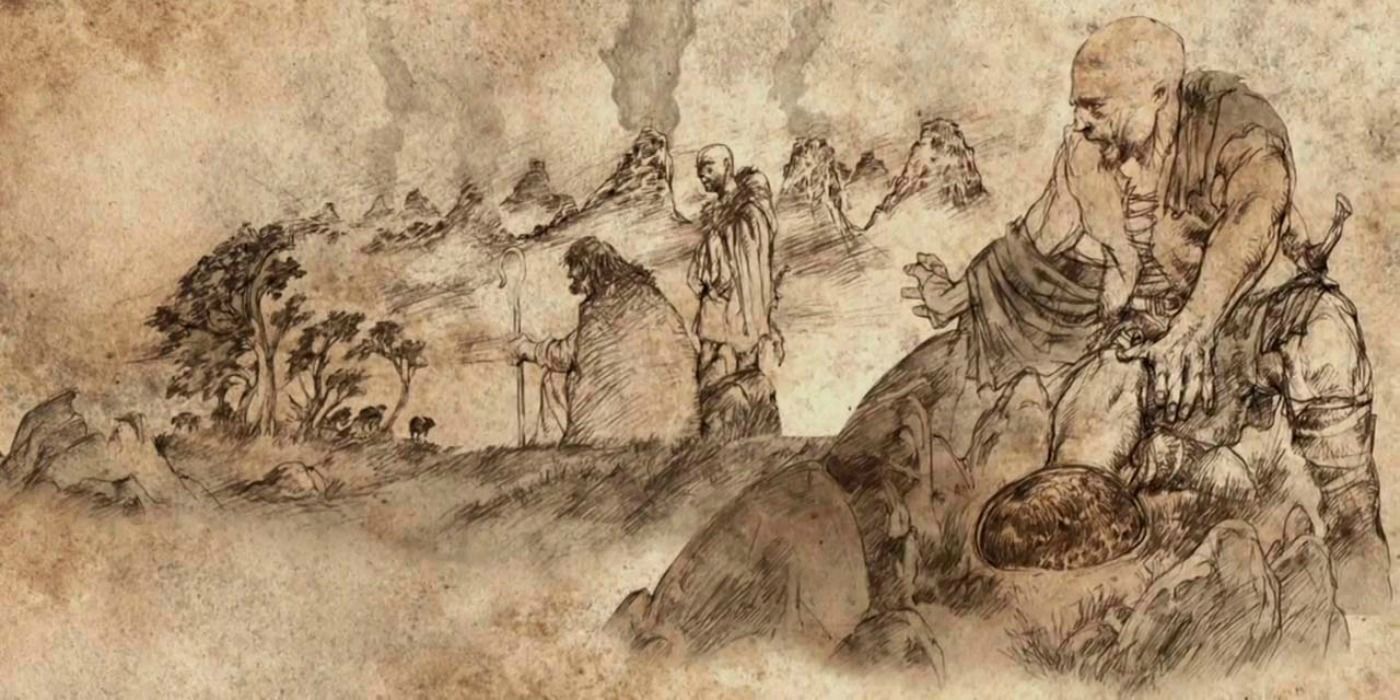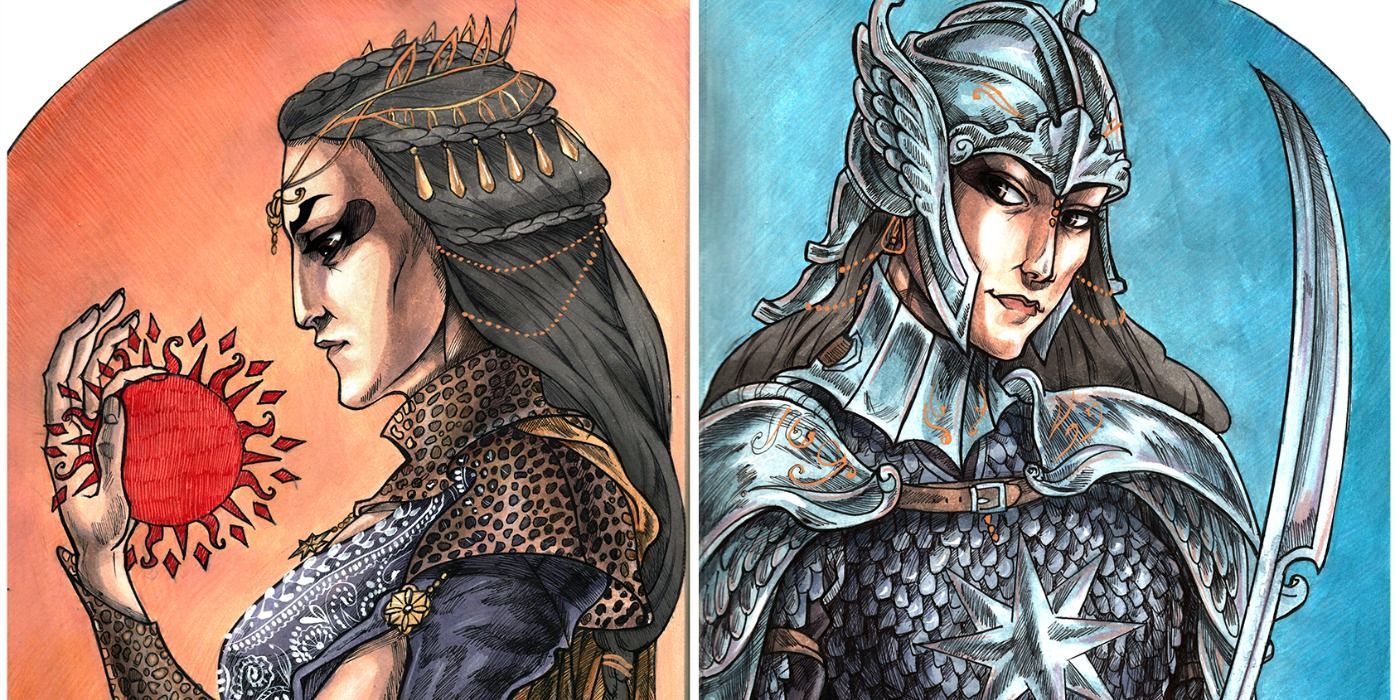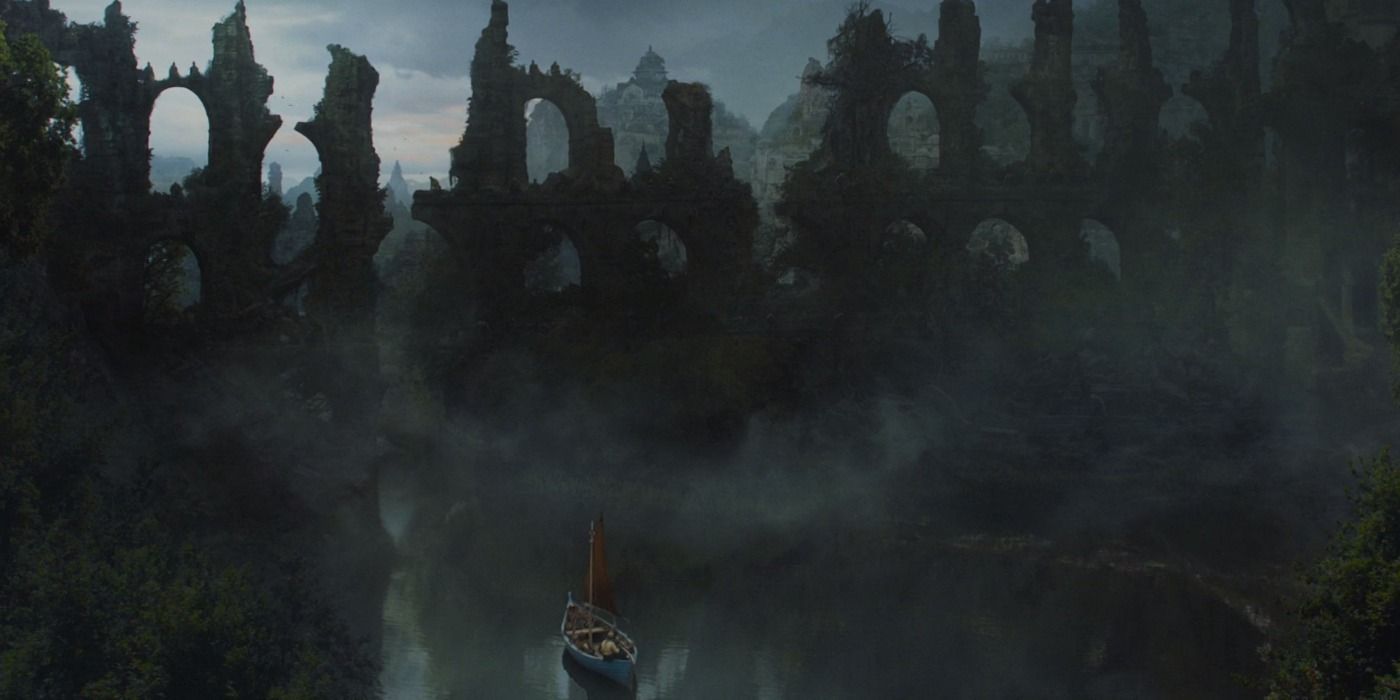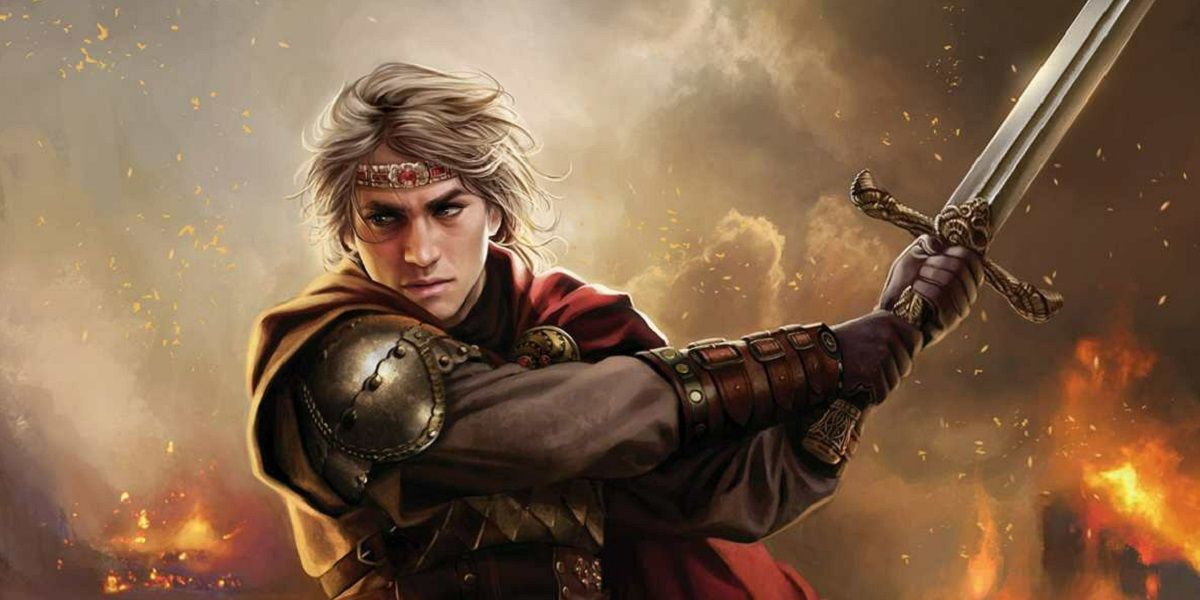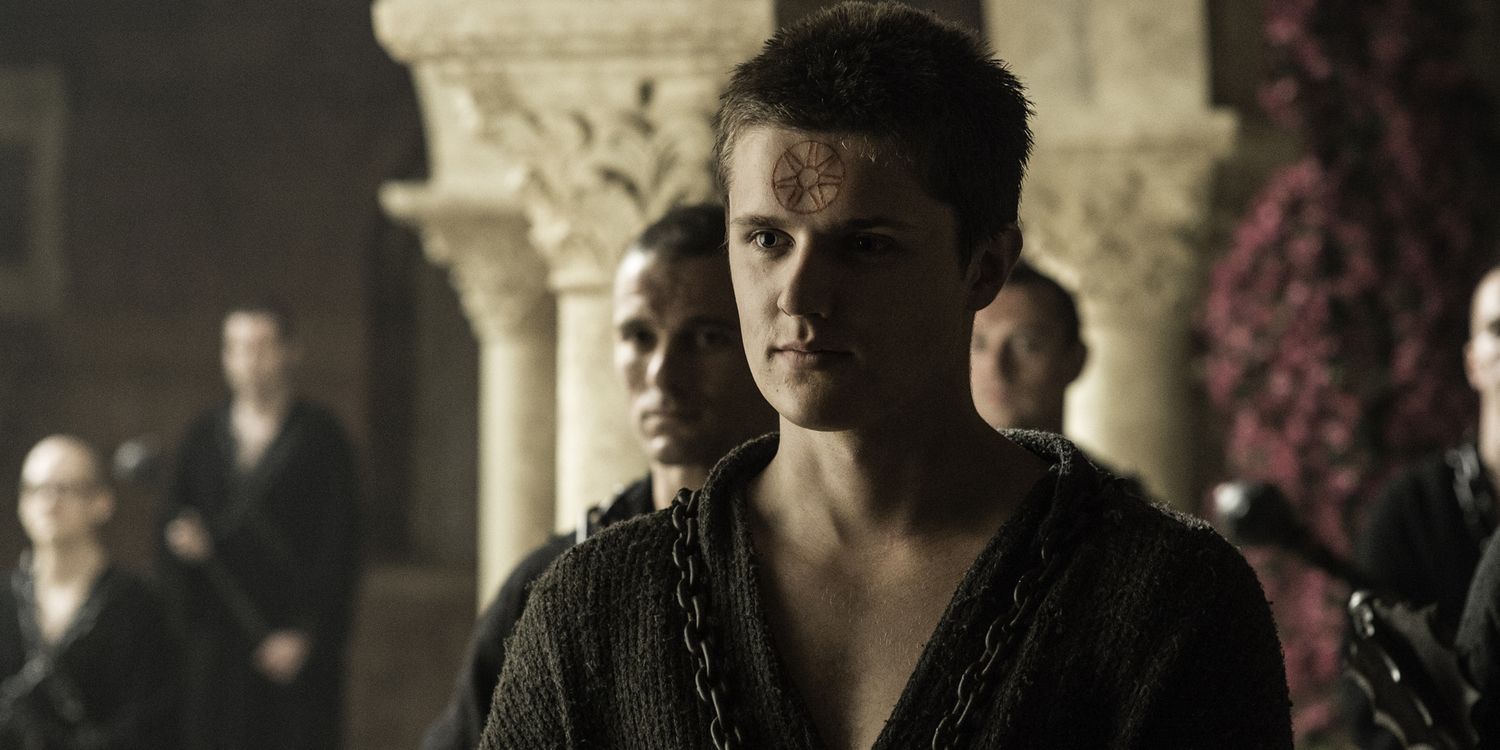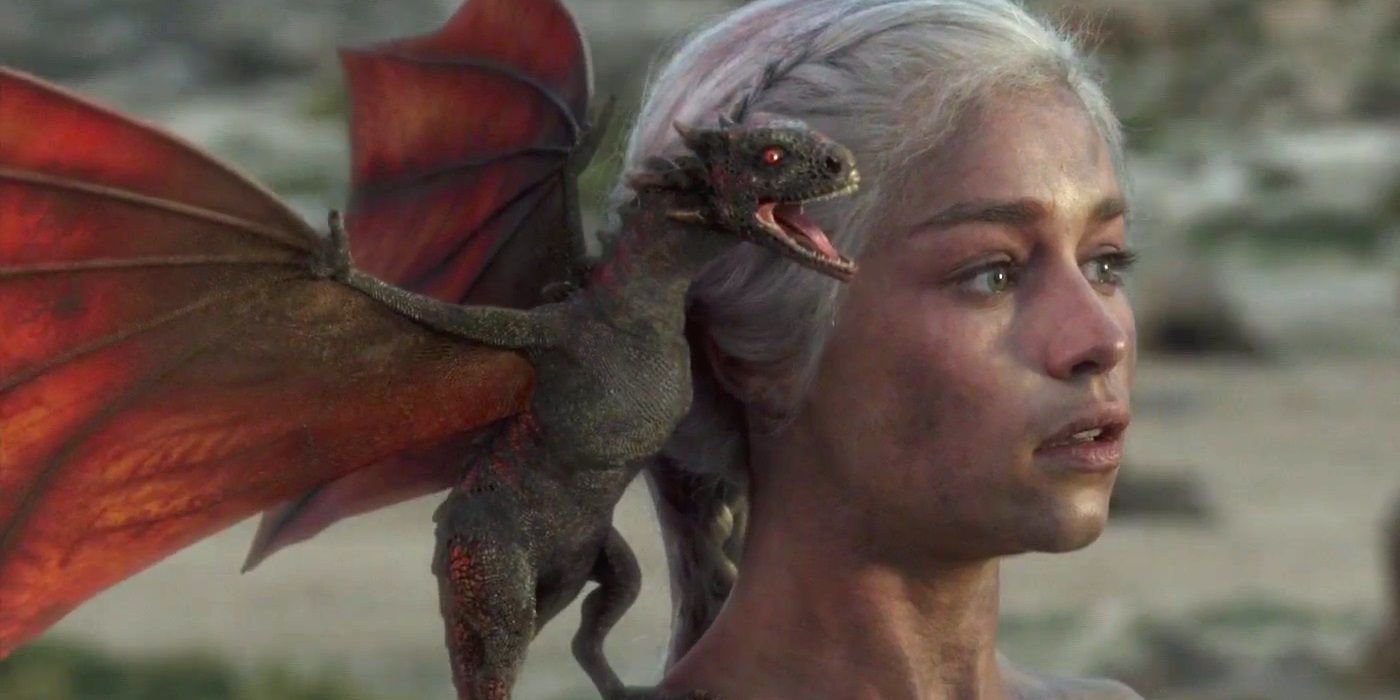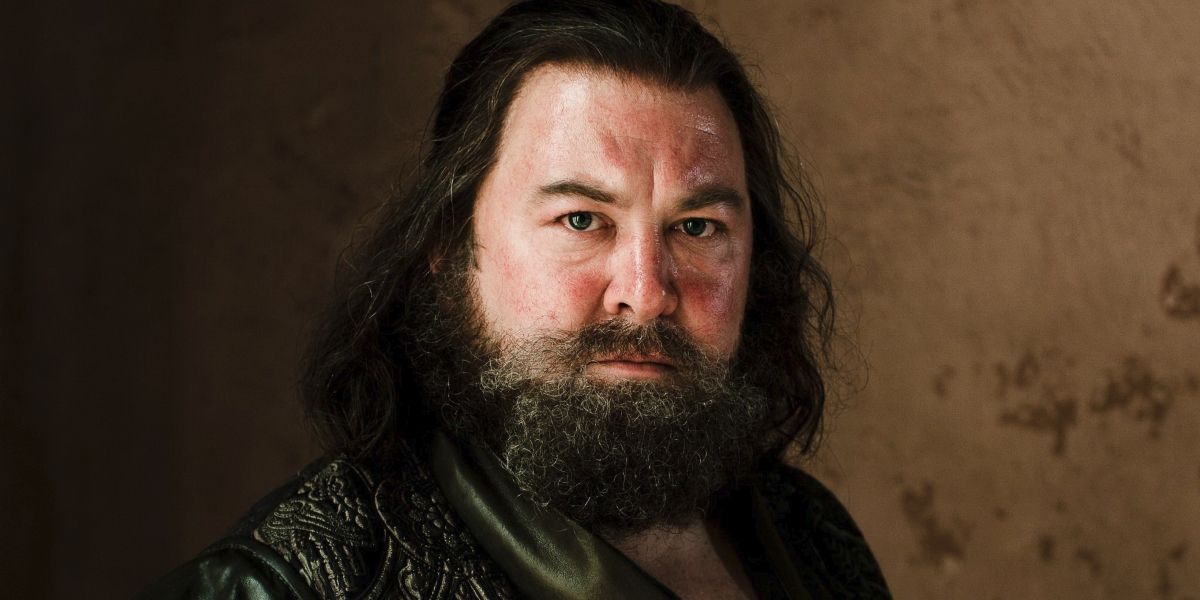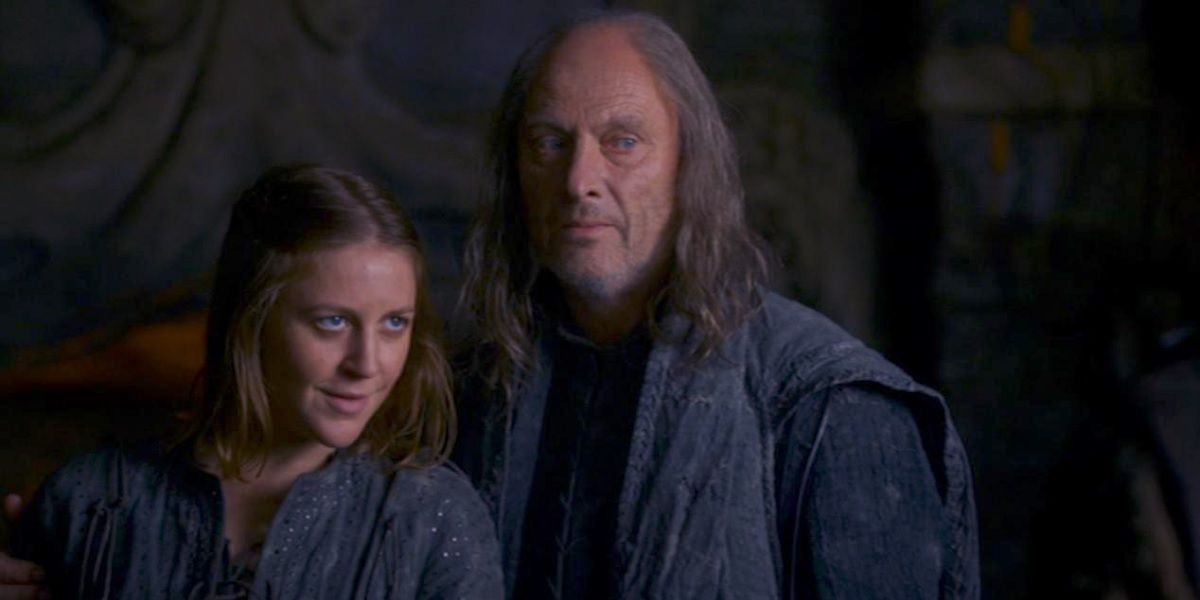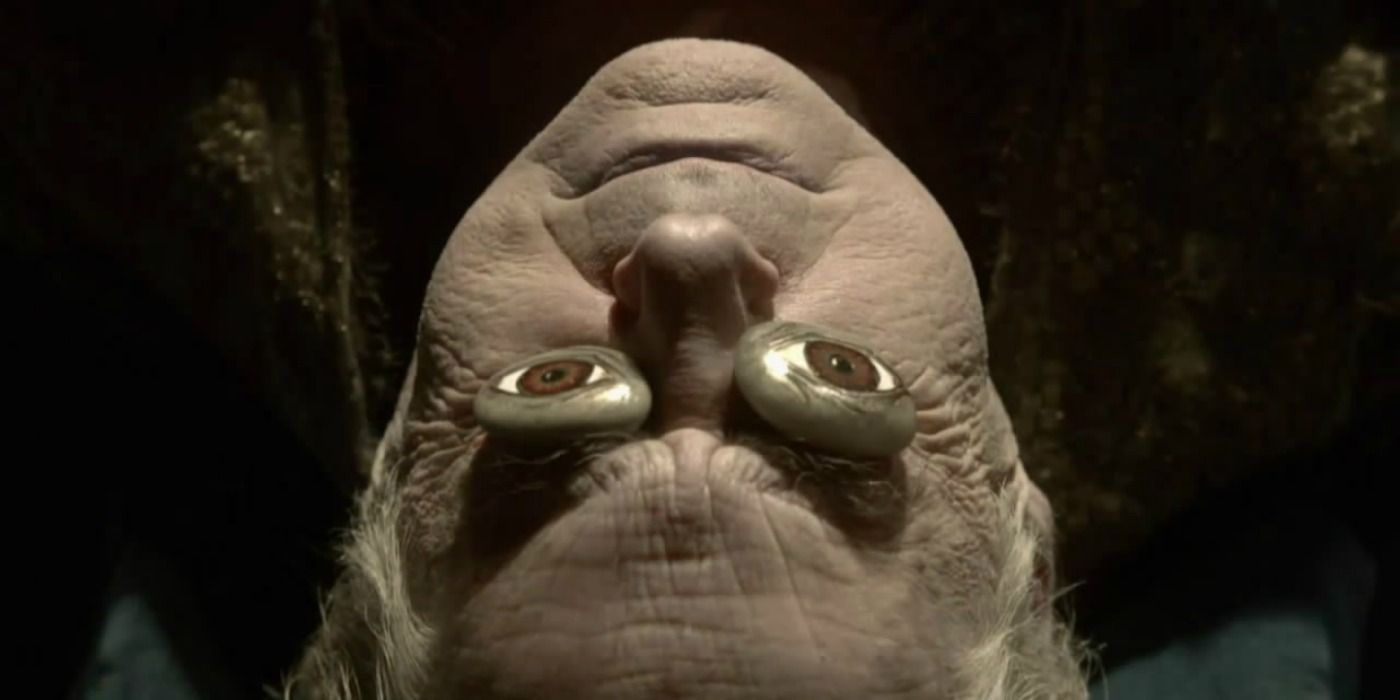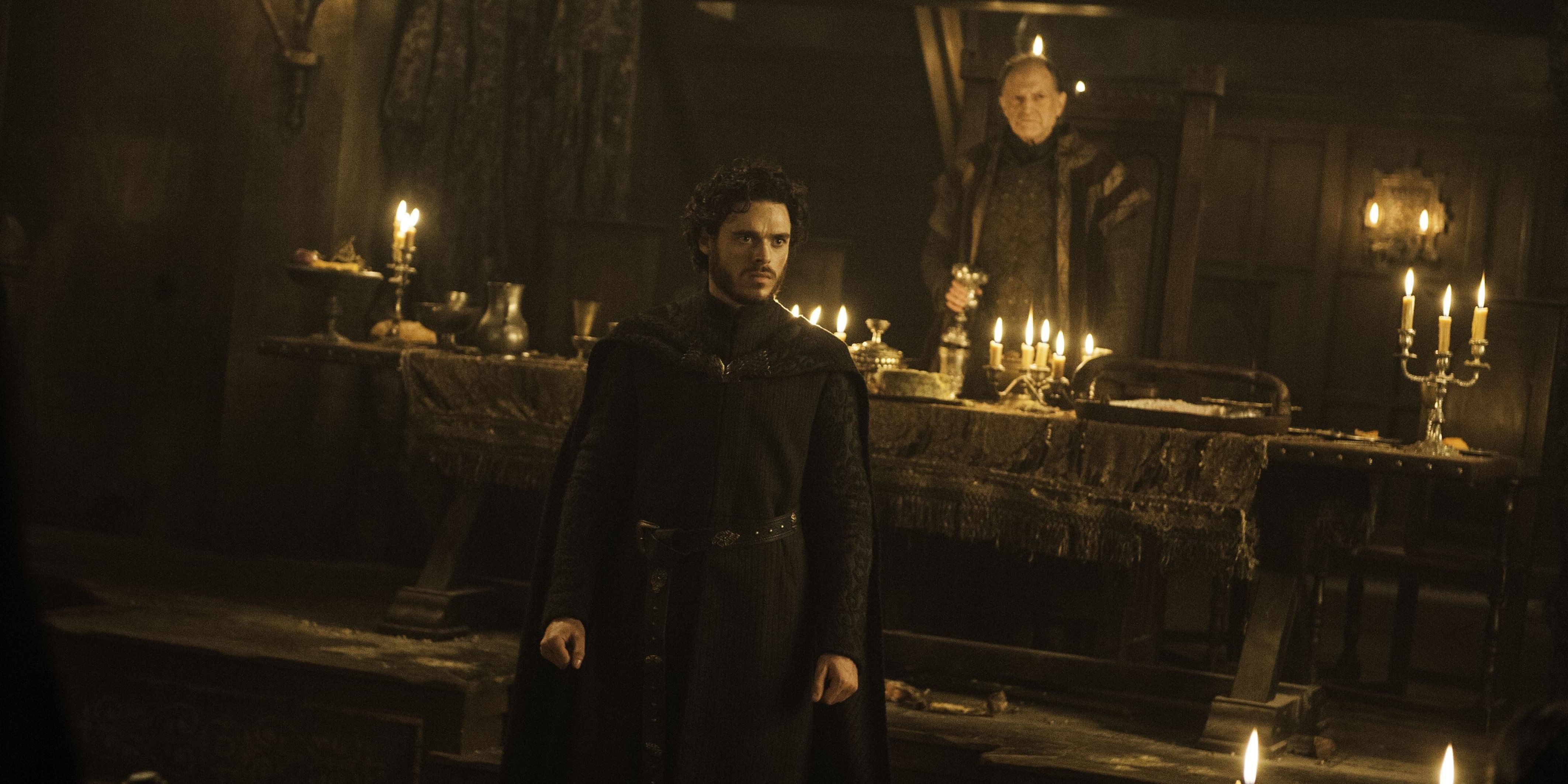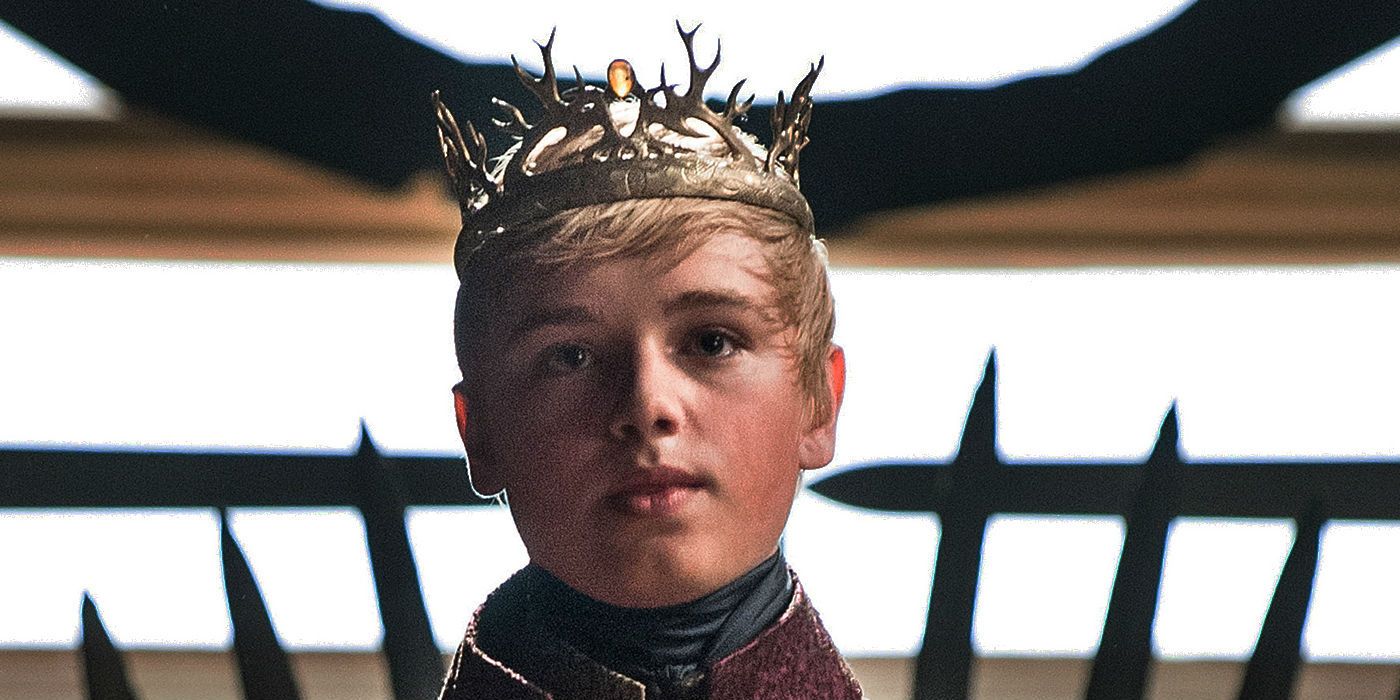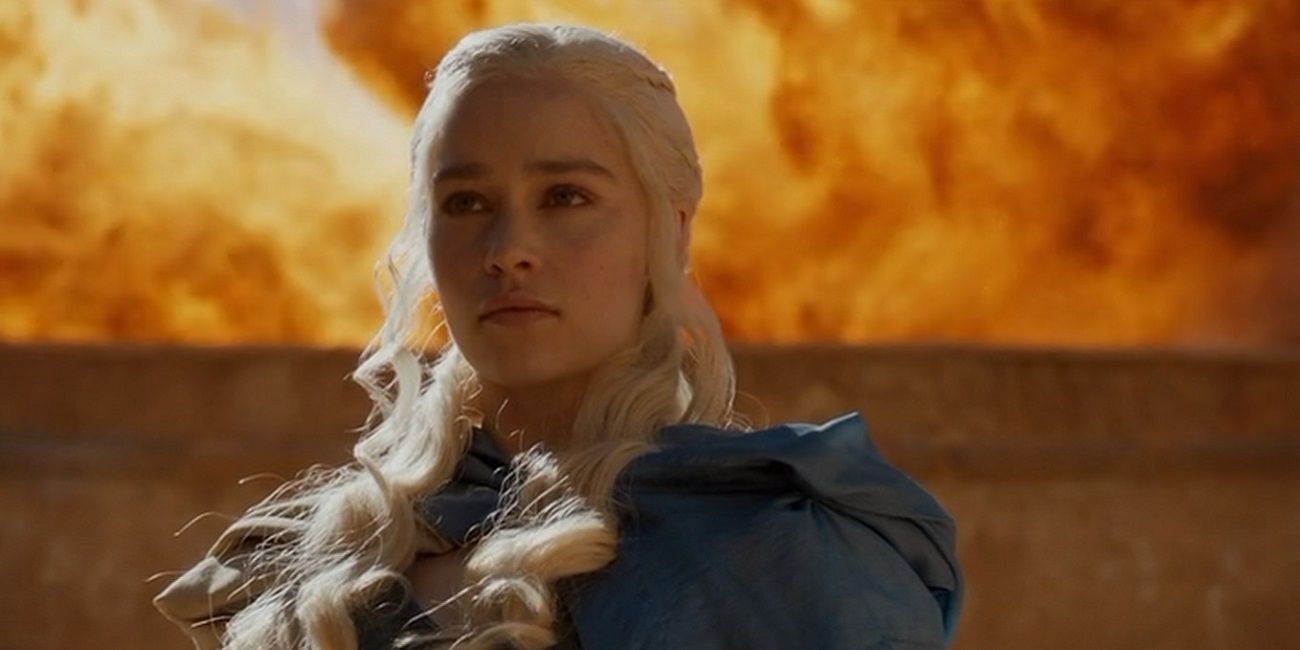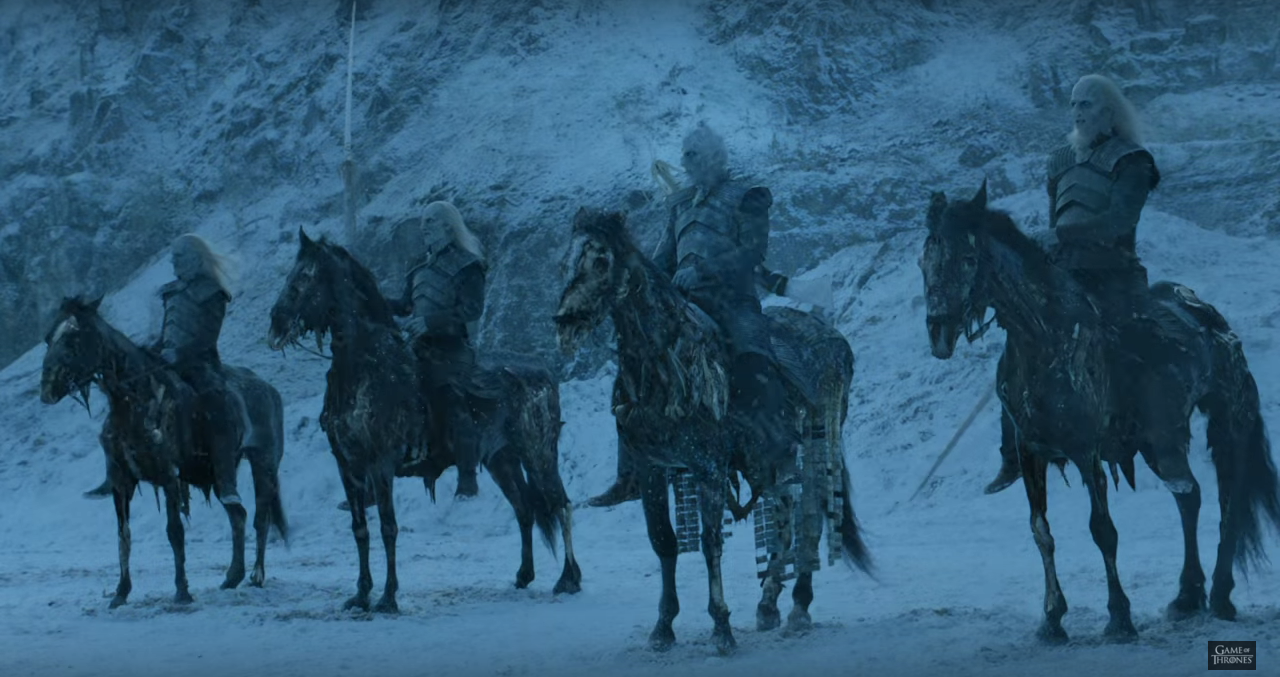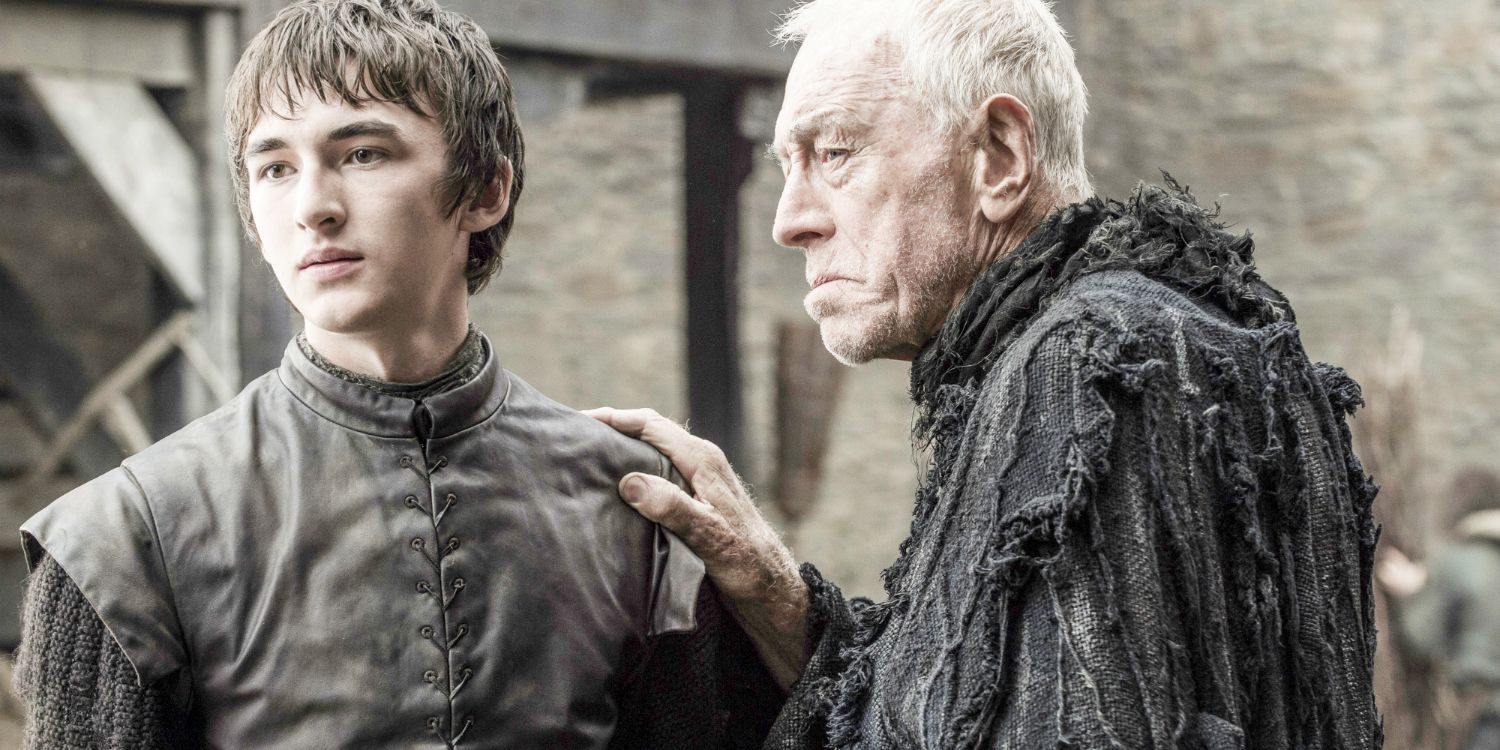[This post contains SPOILERS for the sixth season of Game of Thrones]
–
Although a generally faithful adaptation, Game of Thrones has consistently and deliberately cut nearly all mentions of the history of the Seven Kingdoms of Westeros in an effort to trim as much narrative fat off of the plot bone as possible. While this has served the show in fine stead for its first five seasons, season six has unexpectedly had this 12,000-year-long history come popping up into the main story, setting the stage for the series’s final two (partial) seasons and attempting to provide as much of the same payoff as author George R.R. Martin will do in his final two upcoming novels as possible.
This, understandably, has left many fans scratching their heads as to what everything means. In an effort to make this convoluted backstory as clear as possible – particularly for tonight’s season finale, which promises to be a doozy – we’ve compiled a brief-but-thorough Complete History of Game of Thrones. While you won’t, sadly, learn all of the finer points of Aegon the Conqueror’s campaign to subdue the seven kingdoms, you will have a strong grasp of the Westerosi basics.
Before Game of Thrones
The Dawn Age – 12,000 years ago
The First Men arrive in Westeros via a naturally-occurring land bridge that connects the continent with Essos. Bringing their own culture and religion, they also bring along something that Westeros had never seen before: technology. Outfitted with bronze swords and boiled-leather shields, and utilizing horses for travel and combat, the First Men start to claim the land for themselves, chopping down forests to make room for their new settlements.
This displaces the original Westerosi inhabitants, a race of diminutive, magical beings that come to be called the children of the forest by the First Men; even worse, their revered weirwood trees, which they have the ability to warg into (and peer out of, thanks to the carving of faces into them), are systematically felled, which is sacrilegious to them. War follows.
The children employ their magic (including to smash the land bridge, transforming it into the Stepstone Islands), but they’re no match for the humans’ superior strength and numbers. In a last-ditch effort, they create the White Walkers to essentially act as a series of supernatural super-soldiers. However, this backfires, as the ice zombies, at some unknown point, turn against their masters, too.
A Pact is eventually signed which calls for the two peoples to coexist peacefully. The children agree to remain within the woods, while the First Men vow to leave the forests – particularly the weirwoods – alone. Eventually, they even adopt the children’s religion as their own, worshipping the gods of forest and stream and stone (a practice which remains in the north to this day).
(It’s entirely possible that the truce was necessitated by the growing threat of the White Walkers, but history doesn’t record the first massive invasion of Westeros by the undead beings until a few thousand years later. Perhaps a future episode will address this point.)
The Long Night – 8,000 years ago
A winter that lasts for an entire generation suddenly falls on the entire world, bringing with it the first all-out invasion of the White Walkers. Between famine, exposure, and the war itself, tens of thousands (if not more) of people perish.
In Westeros, the First Men seek out the now-forgotten dwelling places of the children of the forest, looking to forge a military alliance to keep the ice zombies at bay. It works, and the Wall – along with the Night’s Watch, to man it – is created afterwards, to ensure that a surprise attack can never befall the continent again. The children provide the first brothers of the Watch with several hundred obsidian daggers, the only weapon known to injure the Walkers.
Across the narrow sea, the Essosi rally around a legendary figure mostly known as Azor Ahai, who forges an unstoppable magical sword, Lightbringer, by tempering it in the blood – and, possibly, the soul – of his wife, Nissa Nissa. The red priests and priestesses of R’hllor, the fire god (such as Lady Melisandre [Carice van Houten]), predict that the Long Night will one day return, followed shortly by Azor himself, who will be reincarnated to save mankind anew.
The Andal Invasion – 6,000 years ago
Aided by the relatively new technology of shipbuilding and navigation, a group of people called the Andals leave Essos behind and strike out for a new home in Westeros, just like the First Men did six thousand years earlier. And just like their predecessors, the Andals begin a violent colonization process, starting a long-lasting war with the First Men as they push their way up north.
Once again, a truce is eventually signed, resulting in the harmonious cohabitation of the land. The First Men remain in the north, where they continue to pray to the Old Gods, while the newcomers take all the rest of the continent, establishing their new Faith of the Seven (of which the High Sparrow [Jonathan Pryce] was the most recent leader). The Andals’ cultural invention of knights and chivalry, however, will eventually become practiced all throughout the land.
Another side-effect of the migration is far less positive, however: the complete disappearance of the children of the forest in the face of the greater human presence. Soon, the humans believe them to be extinct, and (in time) just a myth.
The Rise of the Valyrian Freehold – 5,000 years ago
Originally just one of countless societies scattered all across the large landmass that is Essos, Valyria left its provincial, sheep-herding ways behind when it discovered the presence of dragons within its borders (nesting in a massive ring of volcanoes). Once the Valyrians learn how to employ magic to domesticate the massive beasts, they quickly establish themselves as the greatest political and military power that the world has ever known, reigning for some five millennia.
The previous Essosi superpower, the Old Empire of Ghis, attempts to stave off its extinction by going to war some five times with the Valyrians, but its legions of lockstep soldiers (most likely slaves, like their present-day Unsullied successors) were no match for dragons. The Valyrian Freehold swells to include the former Ghiscari territory, including Slaver’s Bay (where Daenerys Targaryen [Emilia Clarke] currently calls home), and even extends all the way westward to the very edge of Westeros itself, forming the remote outpost of Dragonstone (which would eventually be controlled by King Stannis Baratheon [Stephan Dillane]).
The Rhoynar Exodus – 1,000 years ago
The third and final major migration into Westeros is instigated by the Valyrians, who attempt to continue to push their imperial holdings all across Essos. The Rhoynar, an egalitarian people who had settled all along the mighty Rhoyne River, are soundly defeated in war (water magic is, apparently, useless in the face of dragons), prompting their warrior-queen, Nymeria (the figure for whom Arya Stark [Maisie Williams] names her pet direwolf), to set sail for a new home. They ultimately find Dorne, where Nymeria marries into House Martell and promulgates her people’s socially liberal culture - explaining why Dorne remains so unique amongst all the other kingdoms of Westeros (including their usage of “prince” for their monarchs instead of “king”).
The Doom of Valyria – 412 years ago
After five millennia of unbroken dominance, the Valyrian Freehold abruptly falls when a disaster of unknown nature strikes Valyria, turning the peninsula into a series of islands. (It seems doubtless that the huge chain of volcanoes running through the country is responsible for the cataclysm, but we’re unsure whether their massive and unprecedented eruptions were either magical or strictly geological in nature.) The now-flooded area has been called the Smoking Sea ever since.
There are two powerful effects of the so-called Doom of Valyria: firstly, all Valyrian spells, knowledge, and recorded history are forever lost; secondly – and more profoundly – the rest of the dragonriders’ empire almost instantly crumbles along with its homeland, leaving many regions and former colonies to declare their independence (including Slaver’s Bay and the Nine Free Cities).
Aegon’s Conquest – 298 years ago
Just 12 years before the Doom of Valyria, Daenys Targaryen had a prophetic vision (a family trait that would continue on down through the centuries) of the apocalyptic fall of the Freehold. She begs her father to move House Targaryen to the remote safety of Dragonstone, which he does, saving his family and allowing them to become the sole remaining standard-bearer of the former empire.
In the century after the Valyrians’ fall, the Targaryens attempt to expand their holdings, to recreate their own little slice of the Freehold. However, it isn't until the arrival of Aegon that their dreams of conquest are realized. At first intervening in the near-constant warring between the Free Cities, Aegon quickly chooses to turn his back entirely on Essos and do something which had never been done before: unite all of Westeros into one giant, overarching kingdom. (By this point in time, the several hundred kingdoms that the First Men had originally founded had been whittled down to just seven, thanks to neighbors assimilating one another through military conquest or marriage alliances.)
Aegon’s Conquest sees him, his two sister-wives (Visenya and Rhaenys), and their three dragons (Balerion, Vhagar, and Meraxes, respectively), supported by a comparatively small number of soldiers, overpower six of the seven kingdoms, with some of the competing kings being slain in battle and others voluntarily submitting to King Aegon I Targaryen. After just two short years, the seven kingdoms of Westeros become the Seven Kingdoms of Westeros. The after-effects are profound: the Iron Throne is assembled out of the melted-down swords of all of Aegon’s fallen foes; King’s Landing, the new capital city, is constructed on the spot of his initial landing and the beginning of his campaign; and the former kings are given new titles, such as the Starks, who used to reign as the Kings in the North but are now called the Wardens of the North.
Although Dorne technically still remains independent of the new Targaryen rule – it's the only kingdom to successfully withstand the might of the dragonriders – it will, 187 years later, be brought into the monarchical fold through a marriage arrangement that would see the then-current prince of Dorne marry a Targaryen princess.
The Faith Militant Uprising – 257 years ago
Aegon I Targaryen’s son, Aenys I, takes the throne upon his father’s death and immediately – although inadvertently – proceeds to agitate the Faith of the Seven, which, at this time, has something of a large-standing army that calls itself the Faith Militant. The final straw comes when King Aenys marries his son to his daughter; although it's a long-standing Targaryen tradition to inter-marry, the Faith denounces it as an affront to the gods. War follows, lasting for seven long and bloody years.
It is not until Jaehaerys I inherits the throne that an end to the uprising arrives, suddenly and peacefully. The new king negotiates a peace treaty with the High Septon; in exchange for Jaehaerys formally pardoning all mutineers and swearing an oath that the Iron Throne will always defend the Faith, the Faith Militant is disbanded and the practice of religious trials is ended.
This status quo lasts for the next two-and-a-half centuries, until Queen Regent Cersei Lannister (Lena Headey) reverses King Jaehaerys’s pact for momentary – and, thus far, fleeting – personal gain.
The death of the last dragon – 145 years ago
King Aegon III Targaryen, only the seventh king of the unified Seven Kingdoms of Westeros, earns the dubious distinction of being the last monarch to preside with actual dragons. The magical creatures had been becoming progressively weaker and more stunted over the course of the past century – particularly after the bloody Targaryen civil war (called the Dance of the Dragons), which ended 22 years previously, claims many dragons’ lives – and while Aegon does his best to breed healthy offspring, all that he can manage to produce are sicklier hatchlings. He's unable to prevent the very last of these from dying, which earns him the name “Dragonbane” and which has the effect of dramatically undercutting the potency of magic all throughout the world.
Robert’s Rebellion – 17 years ago
Rhaegar Targaryen, the crown prince, “abducts” Lyanna Stark (Aisling Franciosi), Eddard Stark’s (Sean Bean) sister, and proceeds to hold her hostage and “rape” her. However, this is only the official summary of events, as told by Robert Baratheon (Mark Addy) and Ned Stark after the fact. There is some reason to believe that Lyanna went with Rhaegar willingly, as they might have been secretly in love, even though he was already married and had two children of his own.
Lord Rickard Stark, the Warden of the North, and his older son and heir, Brandon, demand justice. King Aerys II, the 17th Targaryen monarch, calls them to King’s Landing – only to torture and execute them. Additionally, in order to prevent further “rebellion,” he demands the heads of Eddard Stark and Robert Baratheon, who are being fostered at the Eyrie under the watchful (and instructive) eye of Lord Jon Arryn (John Standing), the Warden of the East.
Already nicknamed “the Mad King” for his increasingly erratic behavior (largely believed to be the by-product of centuries of Targaryen inbreeding), these rather unjustifiably violent acts are the last straw for many in the realm. Houses Stark, Baratheon, and Arryn openly declare war, summoning many of the other Great Houses of Westeros to their cause of overthrowing Aerys. Robert’s Rebellion, as it comes to be known, lasts for one year and results in the deaths of Prince Rhaegar (who is killed by Robert in single combat) and King Aerys II (by Ser Jaime Lannister [Nikolaj Coster-Waldau], a member of his own Kingsguard, who stabs him in the back); the murder of Rhaegar’s wife, Elia Martell (the sister of Princes Doran [Alexander Siddig] and Oberyn [Pedro Pascal] Martell), and her two infants by the direct command of Lord Tywin Lannister (Charles Dance); and the ultimate scattering of Aerys’s two remaining children, Prince Viserys (Harry Lloyd) and Princess Daenerys (who flee, with the secret assistance of Lord Varys [Conleth Hill], to Essos). After the war’s conclusion, Lyanna Stark also dies in a mysterious event (which we now know to be the birth of her son, Jon [Kit Harington]) at the Tower of Joy in Dorne, where she was secretly being held.
With the fall of House Targaryen, House Baratheon rises to become only the second royal family, with Robert assuming the Iron Throne and Jon Arryn becoming his Hand of the King. It is Jon who makes the marriage arrangements with Cersei Lannister, joining two of the most powerful houses in all of Westeros in order to help heal the wounds of the rebellion.
Other notable developments during the war include the allegiance of House Tully, the masters of Riverrun, to the Baratheon-Stark-Arryn alliance (in exchange for Lysa Tully [Kate Dickie] marrying Jon Arryn); House Tyrell’s remaining sworn to the Targaryens and attempting to siege Storm’s End, the seat of House Baratheon (which was held at the time by Stannis); King Aerys II’s secret plan to level all of King’s Landing with a hidden cache of wildfire (hence Jaime Lannister’s effort to kill him, thereby saving thousands of unsuspecting individuals); and the sudden (and unexpected) arrival of the honorable Ned Stark’s bastard son, Jon Snow, who returns home to Winterfell with him, although this is only a ruse to help hide his nephew – and the last Targaryen prince.
The First Greyjoy Rebellion – 9 years ago
Since House Greyjoy, the lords of the Iron Islands, remained largely neutral in Robert’s Rebellion, preserving its strength, and since Lord Balon Greyjoy (Patrick Malahide) believes that King Robert Baratheon has only a tenuous hold on the Iron Throne, Balon decides to declare the ironborn’s independence, crown himself king, and begin a war by reaving all along the western shore of Westeros.
Balon is wrong on two fundamental counts, however: Robert does have strong support among the Great Houses, and the Royal Navy is bigger and stronger than the Iron Fleet. The Greyjoy Rebellion is over practically right after it begins, resulting in an invasion of the Iron Islands, Balon’s swearing fealty to King Robert personally, and the abduction of Balon’s only surviving son, Theon (Alfie Allen), who is taken to Winterfell to serve as a ward (read: hostage) of Eddard Stark’s – and a measure designed to ensure House Greyjoy’s continued obedience.
During Game of Thrones
The Murder of Lord Hand Jon Arryn
Unbeknownst to King Robert Baratheon, Queen Cersei Lannister has for years been engaged in a secret affair with her twin brother, Jaime, which results in her giving birth to three bastard children: Princes Joffrey (Jack Gleeson) and Tommen (Dean-Charles Chapman) and Princess Myrcella (Nell Tiger Free). When Jon Arryn, the Hand of the King, discovers this terrible truth, he plans on telling Robert but is poisoned before doing so by his wife, Lysa, under direct orders from Lord Petyr Baelish (Aidan Gillen), the master of coin on Robert’s small council. Furthermore, once the deed is done, he has her write a letter to her sister, Lady Catelyn Stark (Michelle Fairley), blaming the whole incident on the Lannisters.
With Jon Arryn out of the picture, Littlefinger knows that King Robert will turn to his dear friend, Eddard Stark, to replace him – and now that the Starks are armed with the belief that the Lannisters are secretly attempting to stage a coup (which, ironically enough, Cersei certainly is), Littlefinger also knows that it’s only a matter of time before the two houses will be at war with one another. He just seeks to drag as much of the Seven Kingdoms into the conflict with them as possible, leaving him in the best position possible to sit the Iron Throne himself.
The War of the Five Kings
War does, indeed, arrive, but it has consequences that no one could possibly see coming. King Robert is himself killed in a hunting accident that is staged by Cersei, allowing Joffrey to claim his “birthright” as king. Ned Stark, who wishes to have the throne follow the rightful path of inheritance to Stannis Baratheon, the master of ships, is branded a traitor by the new royal regime and is executed. In return, the north seeks to reestablish its independence from King’s Landing, naming Eddard’s son, Robb (Richard Madden), the first King in the North since Aegon’s Conquest three centuries earlier.
Seeing the instability that the situation has caused, a number of other individuals also throw their hats into the royal ring: Stannis, who doesn’t desire the throne but will nonetheless do his duty as its rightful heir; Renly Baratheon (Gethin Anthony), Stannis’s younger brother, who fancies himself a better ruler than his cantankerous sibling; and Balon Greyjoy, who sees an opportunity to attempt a second war of independence for his Iron Islands.
The so-called War of the Five Kings lasts for some two or three years (beginning in the first season and ending in the fourth), killing thousands and displacing even more (at a time when the next years-long winter is about to descend, meaning that scores more are likely to perish from starvation and exposure). Renly, Robb, Joffrey, and Stannis are all killed, whether through combat on the battlefield or through assassinations. Tommen Baratheon, young and naïve and easily manipulated (hence Petyr Baelish’s desire to see him ascend to the throne), becomes king and enters into a marriage pact with Margaery Tyrell (Natalie Dormer), who is so hungry to be queen that she’ll do whatever it takes to whomever it takes (including first being married to “King” Renly and then Joffrey, though she is unable to consummate either relationship before her husband is killed).
The Aftermath of the War
In addition to each of the failed monarchs and their armies, a whole score of other senior lords or advisors are also killed, including Lord Tywin Lannister, Joffrey’s and Tommen’s Hand of the King; this leaves far weaker – and far less accomplished – councilors to battle for positions of authority, such as Queen Regent Cersei Lannister, who is so desperate to outmaneuver House Tyrell for influence over King Tommen, she foolishly allows the Faith of the Seven to rearm themselves and sit court over any and all sinners. This comes to include Margaery, for lying about her brother’s, Ser Loras Tyrell (Finn Jones), illicit homosexual “misconduct,” and also Cersei herself, for cheating on her royal husband and committing incest. With her son also falling under the spell of the High Sparrow, Cersei feels she has no choice but to execute all of the Faith's leadership, a number of the competing royal advisors, and, even, practically all of House Tyrell in one fell swoop, blowing up the Great Sept of Baelor with a hidden cache of wildfire left over from Mad King Aerys's reign. Devastated at his personal and professional losses, Tommen shortly follows them, flinging himself out of a tower window. The Iron Throne is now occupied by Cersei herself, making her the first queen in Westerosi history.
In the north, House Bolton, a longtime vassal of House Stark, is finally able to ascend to the position of Warden of the North when it colludes with the Lannisters and House Frey (another minor house that has grandiose dreams against its liege lords, in this case the Tullys) to murder King Robb Stark. The bastard-born Ramsay Bolton (Iwan Rheon) holds Winterfell as his personal seat for a time, personally killing the long-in-hiding Rickon Stark (Art Parkinson) in order to better bolster his claim to dominion over the north.
House Tully is able to defy the Lannister-Frey alliance in the riverlands for a time, withstanding a siege of Riverrun – until Ser Jaime Lannister is personally ordered by King Tommen to resolve the situation as quickly as possible. With Riverrun’s capitulation, one of the very last areas to still cling to the war is finally swept back into the king’s peace.
Untouched throughout the entire, devastating war is the Vale, the region that Lysa Arryn rules over as regent until her son, Robin (Lino Facioli), reaches adulthood and can fully claim the mantle of Warden of the East. With Lysa having secretly fallen in love with Petyr Baelish decades ago, when he fostered at Riverrun with the Tullys as a boy, she is finally able to marry him after the death of her husband, Jon Arryn – until he kills her, that is, thereby claiming the title of regent for himself. Throughout the entire process, he arranges that the Knights of the Vale, one of the greatest armies in all of Westeros, remains safely hidden away in the mountainous east, waiting for the right moment for them to strike, ostensibly as his own personal fighting force.
The Threat in the East: Daenerys Targaryen
Lord Varys, the master of whispers on the king’s small council, and Illyrio Mopatis (Roger Allam), a magister of the Free City of Pentos, conspire for reasons unknown to reinstall the Targaryen dynasty on the Iron Throne even before Robert’s Rebellion is finished and House Baratheon claims the crown for itself. The main part of this plan initially rests on Viserys; they arrange for his sister, the young Daenerys, to be sold off to Khal Drogo (Jason Momoa), one of the most powerful horselords of the Dothraki, in order to utilize his khalasar as the backbone of a Targaryen army.
Viserys, however, ultimately proves himself to be just as mad as his father, Aerys II, and he is killed for his troubles. Dany takes over for him, claiming the remnants of Drogo’s host after he, also, dies, using the three dragons that she inadvertently manages to hatch in her husband’s funeral pyre to inspire devotion in her followers – and fear in her enemies. Believing that she needs to acquire as big of an army as possible before touching down in the Seven Kingdoms, she first acquires a massive host of Unsullied soldiers, the most formidable army in the known world, and then also secures the loyalty of a few sellsword companies (read: mercenaries) and nearly the entire horde of the Dothraki.
Along the way, Dany also believes that she needs as much practice being a ruler as possible before reestablishing the Targaryen dynasty, lest she prove to be as incompetent a monarch as her father. She settles on the city of Meereen, one of the largest in Slaver’s Bay (where she came in possession of her Unsullied troops). Though plagued by an insurgency that rebels against her anti-slavery, reforming ways, she ultimately proves capable of breaking the uprising, thanks to her wide assortment of troops, her dragons (of course), and the presence of some inspired councilors, including Tyrion Lannister (Peter Dinklage), a dwarf who irrevocably turns his back on his house and instead seeks to overthrow his nephew’s regime by reinstalling the Targaryens.
Adding to her cause is, interestingly enough, the ironborn; after the self-styled King Balon is first murdered and then replaced by his brother, Euron (Pilou Asbæk), Balon’s children, Theon and Yara (Gemma Whelan), flee for their safety from the Iron Islands, taking as much of the Iron Fleet with them as possible. They sail across the narrow sea and land at Meereen, hoping to make an alliance with the future Queen Daenerys. After some haggling on her end, they do come to an agreement: the ironborn will provide many of the ships that Dany will need to invade Westeros and pledge to never reave the other six kingdoms again, in exchange for her help in deposing King Euron and installing Yara on the Salt Throne.
With all of the pieces finally in place, Daenerys Targaryen, the future queen of the Seven Kingdoms, sets sail for home – and the biggest invasion that Westeros has ever seen.
The Threat Beyond the Wall: The White Walkers
Underscoring all of this political squabbling is the real threat to the Westerosi: the White Walkers, who have, after all these tens of thousands of years, returned to finish their assimilation of the living.
After quietly amassing their numbers and marching slowly-but-steadily southward, the Night’s Watch – the very institution designed to be on the lookout for their return and provide the main bulk of the humans’ defense against their next attack – belatedly picks up their activity. Lord Commander Jeor Mormont (James Cosmo) calls for a Great Ranging beyond the Wall, to see where all the wildlings have scattered to (they’ve rallied behind Mance Rayder [Ciarán Hinds], the so-called King-beyond-the-Wall, who wishes to fight his way into the Seven Kingdoms in order to have the Wall shield them, as well) and to make direct observations of the Walkers’ numbers and movements. This ranging is almost entirely wiped out by the ice zombies, leaving a vacancy for the post of commander.
It falls to Jon Snow to assume leadership of the Watch, and the job before him is so daunting, he takes the most unconventional approach possible to increase his order’s paltry numbers and to make the best possible defense against the enemy: he welcomes the wildlings through the Wall and offers them a large swath of mostly-uninhabited land to settle. In return, the so-called free folk are expected to abide by the king on the Iron Throne’s rules and to help man the Wall against the inevitable supernatural invasion.
Jon is murdered for his troubles, assassinated by his own brothers who are aghast at the sudden turn in the Night’s Watch’s eight-thousand-year policies. Fortunately for him, Lady Melisandre is temporarily residing at Castle Black (a by-product of King Stannis Baratheon coming to the Watch’s aid during a massive confrontation with the wildlings), and she discovers that she has an ability that some of the red priests and priestesses seem to possess: resurrecting the dead.
Understandably feeling betrayed, Jon decides that a life as a brother of the Night’s Watch is no longer for him; he resigns his post as lord commander and instead embraces his identity as a Stark (even if a bastardized one), helping his sister, Sansa (Sophie Turner), rally the houses of the north (and the various wildling tribes) in order to forcibly take back Winterfell and depose the Boltons as the Wardens of the North. After a protracted battle, Jon and his army emerge victorious – but only after Petyr Baelish is finally ready to unleash his Knights of the Vale, coming to Lady Sansa’s rescue and putting him in an ever greater position of influence over the continent’s developments.
Or so he thinks – after the bravery and skill Jon demonstrates on the battlefield, the various houses of the north rally around him the way they had originally flocked to his half-brother, Robb, declaring him the White Wolf, the new King in the North. Jon, Sansa, and Littlefinger are all shocked at the unexpected turn of events.
The north is finally back in order – but the White Walkers are closer than ever, and the real war is about to begin.
The one to lead them all: Bran Stark
Starting off life as the second-born son of House Stark, Bran (Isaac Hempstead Wright) finds all his dreams of knighthood snatched away in an instant when he falls from a tower at Winterfell and becomes paralyzed from the waist down (Bran was deliberately flung from a window by Ser Jaime Lannister after he accidentally came upon the Kingsguard having sex with his twin sister.) But when one door closes, another opens – in this case, Bran’s ability to warg into other living beings (chiefly his direwolf, Summer) and to, even, have greensight visions of the future.
Bran eventually comes to realize that a three-eyed raven that keeps popping up in his dreams is actually another greenseer, one who is located beyond the Wall and who is beckoning Bran to come join him so as to train him in his newfound abilities (and to essentially become a general of all the forces of the living in the coming battle with the undead). After a perilous journey through hostile territory, Bran does manage to meet the Three-Eyed Raven (Max von Sydow) face-to-face, discovering that he is intertwined in the roots of a massive weirwood tree in a cave system that is attended to by one of, if not the, last settlements of the children of the forest.
Bran learns much during his training – such as how to essentially travel backwards in time to see how past events unfolded – but it is cut short when the young Stark accidentally encounters the Night’s King (Vladimir Furdik), the apparent leader of the White Walkers, while on one of his astral strolls. This allows the Walkers to penetrate the Three-Eyed Raven’s magical defenses, killing him and forcing Bran and his only surviving ally, Meera Reed (Ellie Kendrick), on the run.
-
Have your own historical anecdotes to share with our brief-but-thorough accounting? Still have questions about what this past season of the show has meant? Share them in the comments!

